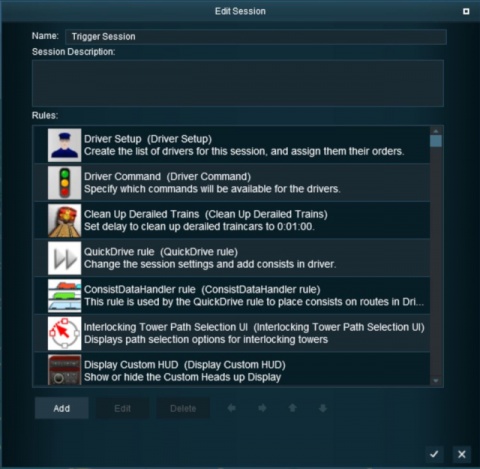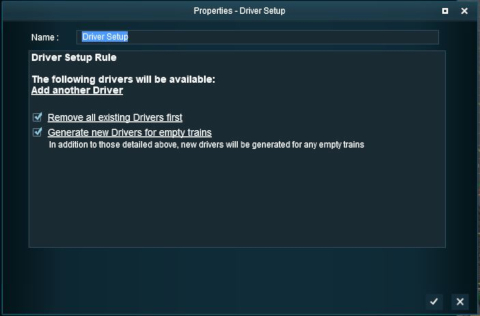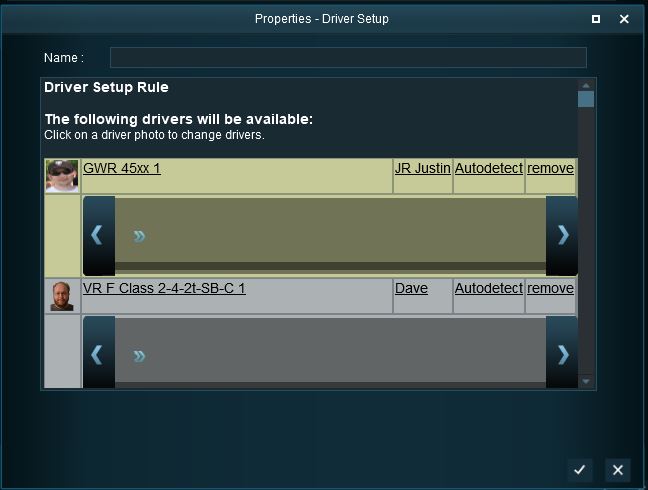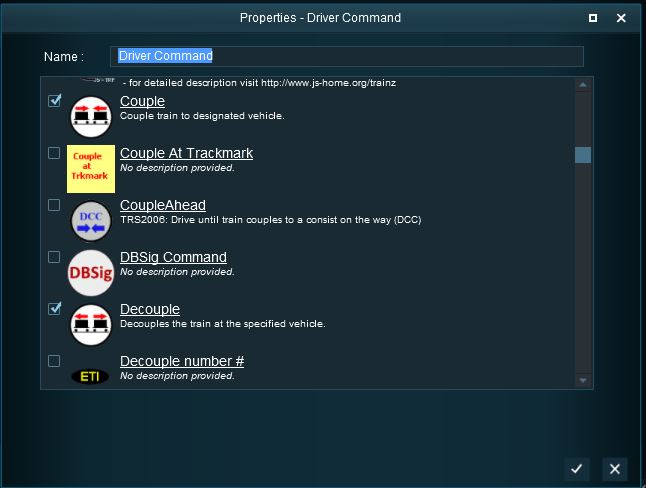How to Use Driver Setup Rule
m (→Adding New Drivers: added image of Driver Setup rules separated by a Wait rule) |
m (remove distinction between TRS19 and TRS19 SP1) |
||
| Line 41: | Line 41: | ||
<td>[[file:Steps.PNG|link=]]</td> | <td>[[file:Steps.PNG|link=]]</td> | ||
<td><span style="font-size: 17px;">'''Steps:'''</span><br> | <td><span style="font-size: 17px;">'''Steps:'''</span><br> | ||
| − | #Open the [[file:WikiLink.PNG|link=]] '''[[How to Use Session Editor|Session Editor]]''' by selecting '''Edit Session''' from the '''Surveyor Main Menu''' in '''TANE | + | #Open the [[file:WikiLink.PNG|link=]] '''[[How to Use Session Editor|Session Editor]]''' by selecting '''Edit Session''' from the '''Surveyor Main Menu''' in '''TANE''' or the '''Surveyor Edit Menu''' in '''TRS19''' and '''Trainz Plus''' |
#Select the '''Driver Setup Rule''' shown left (it is usually the rule at the top of the list) | #Select the '''Driver Setup Rule''' shown left (it is usually the rule at the top of the list) | ||
#Click the '''Edit''' button at the bottom of the '''Session Editor''' window</td> | #Click the '''Edit''' button at the bottom of the '''Session Editor''' window</td> | ||
| Line 145: | Line 145: | ||
<tr valign="top"> | <tr valign="top"> | ||
<td>[[file:Stop.PNG|link=]]</td> | <td>[[file:Stop.PNG|link=]]</td> | ||
| − | |||
| − | |||
| − | |||
| − | |||
| − | |||
| − | |||
| − | |||
| − | |||
| − | |||
| − | |||
<td> | <td> | ||
<table cellpadding="4" bgcolor=#ffffb0> | <table cellpadding="4" bgcolor=#ffffb0> | ||
| Line 164: | Line 154: | ||
</table> | </table> | ||
</td> | </td> | ||
| + | </tr> | ||
| + | </table> | ||
| + | <table cellpadding="4" bgcolor=#ffffb0> | ||
| + | <tr valign="top"> | ||
| + | <td>[[file:PencilTips.PNG|link=]]</td> | ||
| + | <td>If '''Driver Setup Timeout''' errors are reported, then split the drivers between two copies of the '''Driver Setup Rule''' and place the second copy as a child of a [[file:WikiLink.PNG|link=]] '''[[Session Rule List with Parameters#Wait Rule|Wait Rule]]''' set for a delay of just a few seconds.<br> | ||
| + | Information on how to use Parent and Child rules can be found at [[file:WikiLink.PNG|link=]] '''[[Parent and Child Rules]]'''</td> | ||
</tr> | </tr> | ||
</table></td> | </table></td> | ||
| Line 455: | Line 452: | ||
</table> | </table> | ||
<br> | <br> | ||
| − | |||
='''Driver Command Rule'''= | ='''Driver Command Rule'''= | ||
<table cellpadding="4" bgcolor=#c1e7e7> | <table cellpadding="4" bgcolor=#c1e7e7> | ||
Revision as of 12:53, 9 February 2020
The information in this Wiki Page applies to TANE, TRS19 and Trainz Plus.
Contents |
Driver Setup Rule
| Main Points: | |
| The Driver Setup Rule assigns drivers to consists and issues them with Driver Commands. | |
| Driver Commands are lists of instructions or "orders" that drivers are tasked to complete under the control of the Trainz AI system. | |
 |
A list of available Driver Commands can be found on the Trainz Wiki Page at:- |
The Driver Setup Rule is automatically added to the Session Editor of every Session.
 |
|
||||||||||
Adding New Drivers
After selecting the Driver Setup Rule and clicking the Edit button, the Driver Setup Properties Window will be shown. The image below shows the properties window if it is opened with no locomotives placed in the layout.
 |
|
|||||||||
| If your session uses a rule that will expect to find a particular driver in charge of a train (e.g. driver Charlie in the Trigger Check Rule) then manually assign Charlie as the driver of a train and do not select the option Remove all existing Drivers first. |
| When using the Driver Setup Rule for the first time with no drivers assigned to existing trains, the Generate new Drivers for empty trains option will immediately assign drivers to each train. Each time a new train is added to the layout, it will be automatically assigned a driver. |
|
|
|
Settings:
|
|
|
|
|
|
| If Driver Setup Timeout errors are reported, then split the drivers between two copies of the Driver Setup Rule and place the second copy as a child of a Information on how to use Parent and Child rules can be found at |
</tr>
</table>
Editing the Driver List
When drivers and trains have been added to the rule, it will appear as shown below.
 |
|
||||||||||
Adding Driver Commands
The grey area below the driver details (name, loco, owner) is the Driver Command Bar. This is where the driving instructions (the "train orders") used by the Trainz AI system are given to the driver.
 Shown below is a Command Bar after two Driver Commands have been added. Each command has its own icon. Move the mouse pointer onto a command icon to reveal a tooltip showing the contents of the command, as shown in the image. |
|
||||||||||
| Notes: When a driver command has been executed in Driver Mode by the Trainz AI system, it will be deleted from the Command Bar and the next command in the sequence will then be executed. This will continue until the last command has been executed and deleted. Then the AI control of the train will terminate. |
Deleting Driver Commands
To remove a command from the Command Bar...
 |
|
||||||
The "Repeat" Command
| The "Repeat" command is a special built in command that allows all the driver commands to be repeated endlessly. |
 |
|
||||||||
|
 |
|
|
Copying the Driver Setup Rule
| The Driver Setup Rule (and other rules) can be copied between Sessions |
|
|
|
 |
Steps:
|
|
|
|
| Notes: There are some conditions that must be met for this to work.
|
Driver Command Rule
| Main Points: | |
The
|
|
| Removing commands such as Navigate To will force players to manually drive trains when in Driver Mode instead of allowing them to use the Trainz AI system to do all the work. | |
The Driver Command Rule is automatically added to the Session Editor of every Session.
 |
|
The Rule properties window will open to show all the Driver Commands that have been installed in Trainz on your system. This list includes the commands that are built in and those that have been downloaded from the DLS.
 |
|
||||||||||
Trainz Wiki
 |
More Tutorials and Guides to Using Trainz |
This page was created by Trainz user pware in June 2018 and was last updated as shown below.


